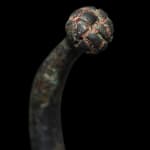Celtic
A Celtic bronze and enamel horn from a helmet, circa 3rd - 1st century BC
Bronze, enamel
Height: 16 cm
Further images
From a horned helmet. The curving hollow bronze horn rises from a circular attachment plate, spiralling and narrowing to a spherical notched terminal inlaid with red enamel.
From a horned helmet. The curving hollow bronze horn rises from a circular attachment plate, spiralling and narrowing to a spherical notched terminal inlaid with red enamel.
Provenance
With Rupert Wace, London, 1995Axel Guttmann (1944 - 2001) Collection, Berlin, inv. no. H 271, acquired in 1995
With Cahn AG, Basel, 2010
Private Collection, Switzerland
Literature
Similar examples of red enamel inlay decoration, as seen on the spherical terminal, can be seen in Celtic workmanship of the Pre-Roman Iron Age. Such inlay on protruding ball-like decorations is typical of Celtic art found in England, France, South Germany, Bohemia, Hungary and even North Italy. For a related example see H. Dannheimer, R. Gebhard (eds.), Das Keltische Jahrtausend, Munich, 1993, p. 352 no. 483.Horned helmets were not just a Bronze Age phenomenon. The ball-like terminals of the horns can be seen on Roman depictions of Celtic horned helmets,on the victory arch at Orange in Southern France, dating to the 1st century BC and which was built to honour the veterans of the Gallic Wars and Legio II Augusta. Roman coins of Julius Caesar also show trophies of Gallic arms including horned helmets. There is also a figure on the famous Gundestrup Cauldron, now in Copenhagen, wearing a horned helmet with very similar horns. The cauldron dates to the 1st century BC and is probably of Thracian origin.





